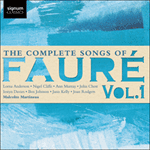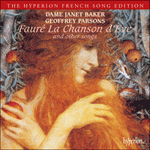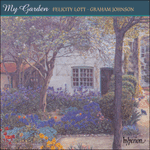Massenet had composed a Verlaine duet as early as 1871. Debussy had set his first Verlaine poems (from
Fêtes galantes, 1869) in 1882; these were
Clair de lune (first version) and
Mandoline. By comparison Fauré came late to Verlaine’s work with his own
Clair de lune of 1887. In 1891 Winnaretta Singer (briefly married to the Prince de Scey-Montbéliard, a union that was papally annulled) encouraged Fauré to write an opera to a Verlaine libretto but this idea came to nothing. When she invited him in the same year to come to Venice on holiday it was perhaps not surprising that he should have taken several volumes of Verlaine with him. The idea of a cycle of songs to these texts occurred to him there – the subject matter of the barcarolle
À Clymène might have seemed especially appropriate in this city of barcarolles. Fauré sketched the first song of the set,
Mandoline, in Venice itself, but otherwise returned to Paris to work on them. It is true that the poems are not about ‘Serenissima’, but the composer regarded these mélodies as being ‘of Venice’, the fruit of a much-needed rest where he relaxed in beautiful surroundings, ‘au bord de l’eau’. This association is celebrated by the songs’ first editions which feature a charming illustration of a gondola on a lagoon with the Campanile and the San Marco basilica in the background. In a letter to the cycle’s dedicatee (the first edition notes her former title, ‘Mme la Princesse Winnaretta de Scey-Montbéliard’) he refers to the songs as being ‘a sort of Suite, a story’.
from notes by Graham Johnson © 2005
Comparé à Massenet, qui avait composé un duo d’après Verlaine dès 1871, et à Debussy, qui avait mis en musique ses premiers poèmes verlainiens en 1882 (la première version de
Clair de lune et
Mandoline, extraits des
Fêtes galantes, 1869), Fauré est venue tardivement à l’œuvre de Verlaine, son
Clair de lune datant de 1887. En 1891, Winnaretta Singer (qui fut un court temps mariée au prince de Scey-Montbéliard – une union annulée par le pape) incita Fauré à écrire un opéra sur un livret de Verlaine, mais cette idée resta lettre morte. Rien d’étonnant, cependant, à ce qu’il ait probablement pris, quand elle l’invita à venir passer des vacances à Venise cette année-là, plusieurs volumes de Verlaine. Car ce fut à Venise que lui vint l’idée d’un cycle de mélodies sur ces textes – le thème de la barcarolle
À Clymène dut lui sembler des plus appropriés dans cette cité de barcarolles. Il ébaucha la première mélodie du corpus,
Mandoline, à Venise même mais, pour le reste, il rentra travailler à Paris. Certes, les poèmes choisis ne traitent pas de la «Sérénissime», mais Fauré considéra ces mélodies comme étant «de Venise», fruits d’une pause bien nécessaire, durant laquelle il se détendit dans un cadre magnifique, «au bord de l’eau». Ce lien vénitien, les premières éditions des mélodies le célébrèrent par une charmante illustration figurant une gondole sur une lagune avec, en arrière-plan, le Campanile et la basilique San Marco. Dans une lettre adressée à la dédicataire du cycle (l’édition princeps mentionne son ancien titre, «Mme la princesse Winnaretta de Scey-Montbéliard»), Fauré parle de ces mélodies comme d’«une sorte de Suite, une histoire».
extrait des notes rédigées par ©


 Fauré: The Complete Songs, Vol. 1
Fauré: The Complete Songs, Vol. 1 Fauré: La chanson d'Ève & other songs
Fauré: La chanson d'Ève & other songs My Garden
My Garden
